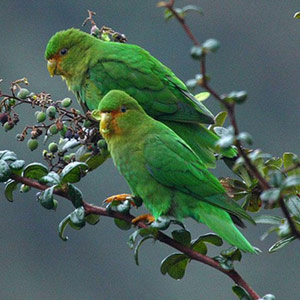Magazine | Études
Biologie et écologie du Toui à front roux dans le parc national de Los Nevados (Colombie)

Touis à front roux (Bolborhynchus ferrugineifrons).Source : Parrot-birds
Introduction
Le Toui à front roux (Bolborhynchus ferrugineifrons) est un petit perroquet endémique de Colombie, à la distribution géographique limitée. Il fréquente la végétation buissonnante (« páramo ») sur les hauts plateaux de la Cordillère Centrale. Peu connu, on le croyait en voie de disparition du fait de la destruction de son habitat, mais il semble qu’il ait une capacité d’adaptation sous-estimée… Juan C. Verhelst, Ana M. Pfeifer, Oscar Orrego et Jorge E. Botero ont étudié la biologie et l’écologie de cette espèce entre mars et décembre 2000 dans les environs de la Laguna del Otún dans le Parque Nacional Los Nevados, une zone importante pour sa conservation.
Abstract
Juan C. Verhelst, Ana M. Pfeifer, Oscar Orrego and Jorge E. Botero studied the population abundance and the general ecology studies of the Rufous-fronted Parakeet Bolborhynchus ferrugineifrons in the Los Nevados National Park, Colombia, mainly in the Laguna del Otún region, between march and december 2000. This area is considered important for the conservation of this endemic and endangered parrot.
They surveyed 297 km of line transects in the four habitats present: super-páramo (11.7%), páramo (68.2%), sub-páramo (15.9%) and andean forest (4.5%) to assess the population status, ecological preferences, and behaviour of the parakeet. Rufous-fronted Parakeet was recorded 18 times each in páramo and sub-páramo, but never in the other two habitats. They observed a total of 377 individuals; relative abundance varied considerably between habitats and localities, from 0.2 to 9.8 individuals/km. Relative abundance was considerably higher in sub-páramo areas around Laguna del Otún-El Bosque. Although páramo was the habitat most intensively surveyed, the species was observed more frequently feeding in or moving through sub-páramo; it was observed seven times in sub-páramo (19% of all records) versus three times in páramo (8% of all records). Parakeets were observed feeding on a wide variety of plants. Their observations suggest that seeds of grass Anthoxantum odoratum and fruits of Acaena elongata are the most important items in the diet. In general, the species was observed more frequently using zones altered by grazing and agriculture.
Poursuivez la lecture de cet article, en vous abonnant dès maintenant !
Découvrez les Archives d’Ornithomedia.com
Pour seulement 10,00 €TTC/an (ou 6,00 € les 6 mois)
Profitez de plusieurs centaines d’articles en accès illimité et sans aucun engagement.
Compléments
À lire aussi sur Ornithomedia.com
- Observer les oiseaux sur le « front pionnier » colombien : le secteur de San José del Guaviare
- Observer les oiseaux dans la Sierra Nevada de Santa Marta (Colombie)
- Première photo du Campyloptère des Santa Marta
- Découverte d’une nouvelle espèce de grallaire en Colombie
- Découverte d’une nouvelle espèce de troglodyte en Colombie
- Description d’un nouveau taxon en Colombie, le Tohi des Yariguies
- Proposition de reconnaissance d’une nouvelle espèce, l’Ortalide de Colombie
Ouvrages recommandés
- Field Guide to the Birds of Colombia de Miles McMullan, Thomas M Donegan et Alonso Quevedo
- The Birds of Costa Rica: A Field Guide de Richard Garrigues (Auteur) et Robert Dean (Illustrations)
- Birds of Costa Rica de Richard Garrigues
- Birds of Costa Rica: A Field Guide de Carrol L. Henderson, Alexander F. Skutch et Steve Adams




Aucun commentaire sur ce sujet
Participer à la discussion !